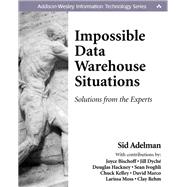This book takes a unique approach to the problems faced by data warehouse professionals. The author and the contributors have gathered over 90 situations that they have been asked about in their seminars and presentations, that they have faced in their own work, and that have been submitted to the very popular "Ask the Experts" forum at DMReview. These are all real situations, but they have been disguised to protect the guilty. Topics covered include staffing, budgeting, security, vendors, architecture, and data quality. Each of the "impossible" situations will have one or more solutions contributed by the expert panel. Their different answers and viewpoints, especially when they disagree with one another, provide enlightening reading, as well as useful ideas. This approach should appeal to a broad range of people involved in all aspects of Data Warehouses.









